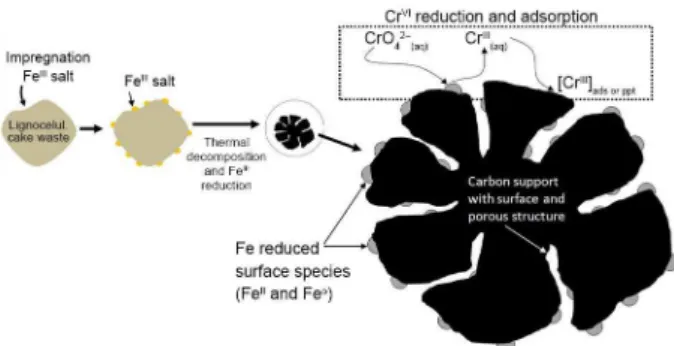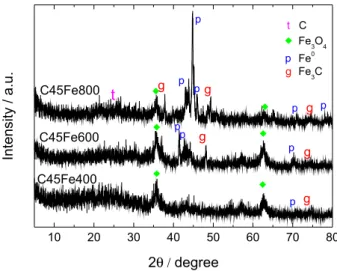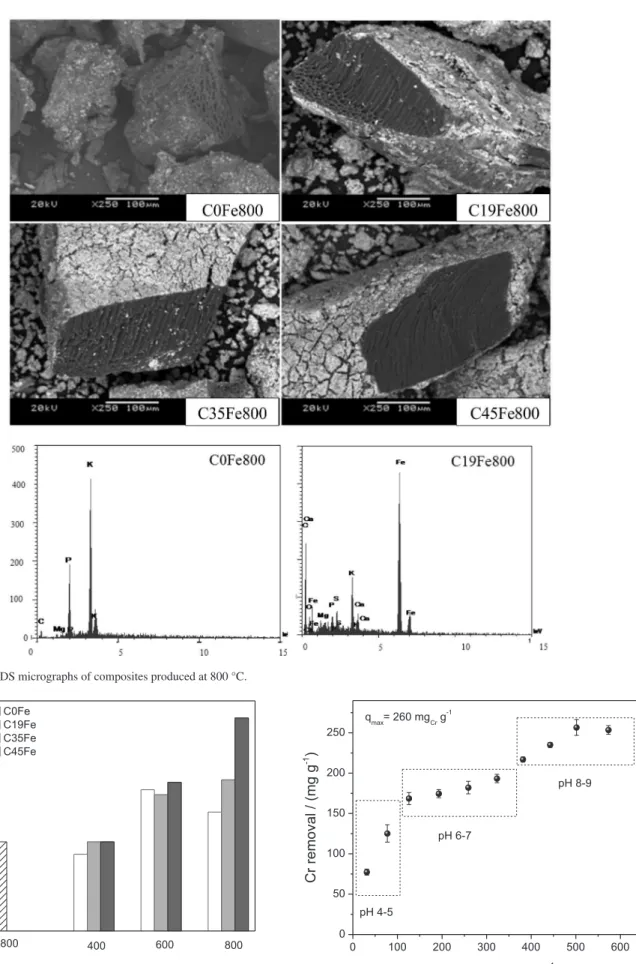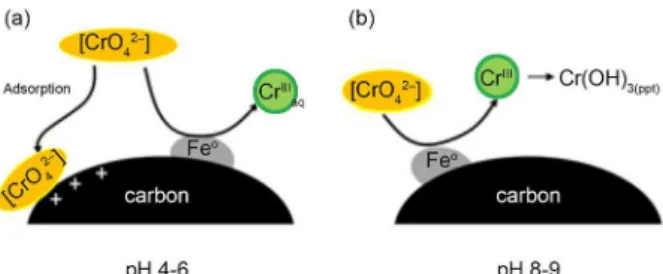Article
J. Braz. Chem. Soc., Vol. 26, No. 10, 2130-2136, 2015. Printed in Brazil - ©2015 Sociedade Brasileira de Química 0103 - 5053 $6.00+0.00
A
*e-mail: leticia@qui.ufmg.br
Use of Biodiesel Press Cake Waste to Prepare Fe/Carbon Reactive Composites for
Environmental Applications: Removal of Hazardous Cr
VIContaminants
Elizângela A. Santos,a Paulo F. R. Ortega,a Rodrigo L. Lavall,a Sérgio C. Reis,b
José D. Ardisson,b Rochel M. Lago,a Clésia C. Nascentesa and Letícia M. Costa*,a
aDepartamento de Química, ICEx, Universidade Federal de Minas Gerais,
Av. Antônio Carlos, 6627, 31270-901 Belo Horizonte-MG, Brazil
bCentro de Desenvolvimento da Tecnologia Nuclear,
Av. Antônio Carlos, 6627, CP 941, 30161-970 Belo Horizonte-MG, Brazil
In this work, Ricinus communis L. press cake waste from biodiesel production was used to produce a versatile reactive material for environmental applications. The biodiesel cake waste was impregnated with FeIII at different concentrations (19-45 wt.%) and treated at 400, 600 and
800 °C. Mössbauer, X-ray diffraction (XRD), thermogravimetric analysis (TG/DTA), scanning electron microscope (SEM), elemental analysis CHN, Raman, potentiometric titration, saturation magnetization and Brunauer-Emmett-Teller (BET) analyses showed that the materials prepared at 400 °C are composed mainly of a graphitic and amorphous carbon containing dispersed magnetite (Fe3O4). At higher temperatures, metallic iron (Fe
0) and iron carbide (Fe
3C) are the predominant
phases well dispersed in the carbon porous structure. These reduced iron species, Fe3O4 and Fe0,
are active for the reduction of different hazardous contaminants. Preliminary experiments showed very high activities for the reduction and removal of aqueous CrVI.
Keywords:biodiesel press cake, reactive Fe phases, carbon support, hexavalent chromium
Introduction
Biodiesel press cakes are solid materials obtained after mechanical pressing and oil extraction consisting mainly of lignocellulosic fibers. These biodiesel wastes have been used mainly for energy production which is not economically
interesting due to the low calorific content.1 Some cakes
have also been used for animal feeding.2 However, due to
the deficiency of proteins and the presence of some toxic compounds some biodiesel cakes cannot be used for nutrition
purposes. For example, castor bean (Ricinus communis L.)
has high oil contents and it has been intensively investigated for biodiesel production. However, due to the presence of ricine, the produced cake is highly toxic and cannot be
used in feed blends for animals.3 Therefore, processes to
convert biodiesel cake wastes into new materials for relevant applications are of considerable interest.
In this work, it was studied the use of biodiesel cake waste to produce a versatile reactive and adsorbent composite based on reduced Fe surface species and porous
carbon for different environmental applications. This composite was produced by a simple process consisting
of FeIII impregnation on the lignocellulosic cake waste
followed by thermal treatment under controlled conditions
to form a multifunctional material. The FeIII is reduced
to form FeII and Fe0 species whereas the lignocellulosic
precursor is decomposed to form a porous carbon with oxygen surface groups (Figure 1).
The reduction of FeIII to form reactive Fe species has
been previously reported in different systems, such as tar
pitch,4,5 activated carbon6 and H
2.7-9 These surface Fe species
can be used for the reduction of different environmental
contaminants such as nitrate,10-12 organochlorine pesticides,13
as permeable reactive barriers5,14 and for oxidations via
the Fenton reaction.8,15,16 Iron species can also reduce the
hazardous CrVI which is widely used in industries such as
leather tanning, electroplating, pigment production, wood
treatment and others.17
Hereon, preliminary results on the preparation of these reactive composites and their use for the reduction and
removal of the hazardous CrVI will be presented.
Experimental
Production of the reactive composites
Ricinus communis L. press cake used as carbon precursor was dried for 72 h at 60 °C. The impregnation of iron was carried out in 50 g of biomass using 68.5, 126
and 162 g of Fe(NO3)3.9H2O solubilized in approximately
300 mL of ethyl alcohol to produce composites Fe/C with 19, 35 and 45 wt.% of Fe. The biomass suspension was dried under stirring and treated at 400, 600 and 800 °C for 1 h in a horizontal tubular furnace using a heating rate of
10 °C min-1 under N
2 at a flow rate of 100 cm3 min-1.
Characterization of composites
The pore structure of composites was analyzed by nitrogen sorption at 77 K using an automatic Autosorb apparatus (Quantachrome Corporation). Fourier transform infrared spectroscopy (FTIR) analyses were carried out in Perkin Elmer BX.
The number of oxygen sites in the surface was analyzed by a potentiometric titration (0.050 g of composites in
25.0 mL of 0.5 mol L-1 NaNO
3) at 25 ± 1 °C using an
automatic Titroprocessor (Methrom, mod. 670). The experimental data were adjusted using a non-linear
regression program, as described in previous studies.18
The zero charge point (pHzpc) was determined using the
solid addition method. In this method, 25 mL of aqueous solutions at different pH values (1-11) were mixed with 0.0125 g of sample. The suspensions were sealed and stirred at room temperature for 24 h at 180 rpm. Subsequently, the pH of the supernatant was measured and the difference
between the initial pH (pHi) and final pH (pHf) values was
plotted as a function of pHi.
The microstructure of the magnetic composites was investigated by scanning electron microscopy (SEM) with JOEL, model JSM-6360LV. The crystal structure was characterized by a Rigaku diffractometer with Cu Kα
radiation. Thermogravimetric analyses (TGA) were carried out with a Shimadzu TGA60H thermo balance device
with air flow (100 mL min-1), at 10 °C min-1. Elemental
analysis was conducted on CHN/S 2400 series II (PerkinElmer). Raman spectra were obtained in a Bruker Senterra spectrometer, with excitation wavelength of 632.8 nm and a helium-neon laser. The laser targeted the sample through an Olympus BX-51 microscope (20× magnification). Mössbauer spectra were obtained at room temperature employing a conventional spectrophotometer
with constant acceleration, 57Co source in Rh matrix, using
α-Fe as reference. Measurements were made of samples pulverized without application of external magnetic field. The spectra were fitted using a numerical program (NORMOS). Magnetization measurements were obtained using a LakeShore 7404 vibrating sample magnetometer
with noise base of 1 × 10-6 emu, time constant of 100 ms and
averaging time of 2 s per point, and measurement time of
101 s. Fields were swept at 1400 Oe s-1. All measurements
were performed at room temperature.
Batch adsorption studies
Preparation of CrVI solution
A hexavalent chromium solution was prepared by
dissolving 2.3 g K2Cr2O7 in 1000 mL of deionized water.
The initial pH was adjusted to 4 with 1 mol L-1 HCl or
NaOH and experimental solutions were obtained by successive dilutions.
CrVI removal
The CrVI removal experiments were carried out using
10 mg of the reactive composite in 10 mL of 50 mg L-1 CrVI
solution at 25 °C for 4 h at pH 4 which guarantees reaction and adsorption equilibrium. After reaction, the composites were separated from solution by a magnet and the total chromium concentration was measured by flame atomic absorption spectrometry (FAAS).
Results and Discussion
The composites prepared with different iron contents and temperatures have been named hereon as CXFeY, where X is the iron content (0, 19, 35 or 45 wt.%) and Y is the treatment temperature (400, 600 or 800 °C). X-ray diffraction (XRD) powder diffractions analyses for the composites showed in general low crystallinity (see Supplementary Information for all XRD patterns, Figure S1). The XRD of the composites containing 45%
Fe reduced at 400, 600 and 800 oC suggested the presence
Mössbauer analyses of the composites containing 45 wt.%
Fe treated at 400, 600 and 800 oC are shown in Figure 3.
The Mössbauer data for the sample C45Fe400 confirms
the presence of magnetite Fe3O4 (with 17% relative area) and
dispersed FeIII (83%). After treatment at 600 °C (C45Fe600),
the main reduced phases observed were α-Fe (3% relative
area), γ-Fe (7%), Fe3C (19%), Fe3O4 (6%) and disperse FeIII
(65%). At 800 °C (C45Fe800) a significant FeIII reduction
was observed with concentration decrease to 29%, whereas reduced iron phases increased, i.e., α-Fe (20%), γ-Fe (11%)
and Fe3C (40%). The FeIII present in small amounts was
likely formed by the oxidation of reduced iron species when the sample was exposed to air at room temperature. A general idea of the Fe phases present in the different composites is shown in Figure 4. The Mössbauer spectra and hyperfine parameters for all the composites are shown in Supplementary Information (Figure S2 and Table S1).
Similar results were found by Oliveira et al.19 and
Mendonça et al.20 where FeII and FeIII predominate at low
temperatures and Fe0 and Fe
3C are formed above 550 °C.
These results suggest that FeIII can be reduced by carbon
according to the simplified equations 1, 2 and 3.
(1)
(2)
(3)
Magnetization values varying from 0.1 to 20.1 emu g-1
(see Supplementary Information, Table S2) were found for the obtained composites, which are due to the formation
of the magnetic phases Fe3O4, Fe0 and Fe3C showed by
Mössbauer.
Raman spectra (Supplementary Information, Figures S3 and S4) for all obtained composites showed the two typical bands for carbon materials, i.e., the G-band related to tangential vibration modes of well-organized graphitic
structures at 1500 cm-1, and the D-band at 1300 cm-1
10 20 30 40 50 60 70 80
t t p g g p p p p p p p p g g g g C45Fe400 C45Fe600 C45Fe800
2θ / degree
Intensity / a.u.
g
p
Fe3C Fe0 Fe
3O4
C
Figure 2. Powder XRD patterns for the composites with 45 wt.% Fe treated at different temperatures.
Figure 3. Mössbauer spectra at 298 K for the samples C45Fe400, C45Fe600 and C45Fe800.
Figure 4. Iron content phases for the composites containing 19, 35 and 45 wt.% Fe treated at 400, 600 and 800 °C.
10 20 30 40 50 60 70 80
t t p g g p p p p p p p p g g g g C45Fe400 C45Fe600 C45Fe800
2θ / degree
Intensity / a.u.
g p
Fe3C Fe0 Fe
assigned to defective carbon structures, such as amorphous
carbon.21 The G’ band near 2700 cm-1 confirms the presence
of graphite like structures.21
The carbon contents in the pyrolized materials were determined by CHN analyses. TGA (Supplementary Information, Figure S5) showed a complex behavior due to at least three reactions taking place simultaneously: the oxidation of carbon, the oxidation of Fe phases and the reaction of Fe oxide phases with the carbon. The exothermic weight losses near 350 °C related to the oxidation of the carbon support were used to confirm the percentage of
C.22 The carbon contents determined by CHN analyses for
the composites obtained after treatment at 800 oC were
58, 50 and 45% for the composites C19Fe, C35Fe and C45Fe, respectively (see all analyses in Supplementary Information, Table S3).
The composites were also analyzed by N2 adsorption
to determine the surface area (SBET) and pore distribution
(D). The obtained results are shown in Table 1.
The composites obtained at 400 oC did not show any
significant surface area. On the other hand, composites with
surface area up to 79 m2 g-1 with the presence of porous
with average diameter of ca. 3-4 nm, were obtained at 600
and 800 oC. These results clearly show that the presence
of FeIII has an activation effect to generate surface area and
a mesoporosity.
The morphology of the composites was investigated by SEM and the images obtained presented in Figure 5.
The SEM images suggest that the thermal treatment of the cake produces irregular particles with sizes varying from few micrometers up to 500 µm with the presence of internal large pore spaces. SEM images show that upon impregnation of Fe nitrate and thermal treatment a bright surface layer is formed, which is related to Fe species as suggested by energy dispersive spectroscopy (EDS) analyses.
Potentiometric titration experiments showed the presence of surface groups, likely related to oxygen functionalities. Estimation of pKa of these groups suggests
the presence of carboxylic groups (pKa < 6), lactone and quinine groups with pKa > 7 (see Supplementary Information, Table S4). It is interesting to observe that the obtained zero charge point (ZPC) for the composites ranged from 8 at 10 which cannot be explained by these
oxygen surface groups with typical ZPC 2-4.23 These results
suggest that the iron oxides (with pHZPC typically above 8)24
present on the carbon surface are likely responsible for the observed surface charges.
Batch experiments of CrVI removal from aqueous
solutions were carried out using the 12 different prepared composites (Figure 6).
The lignocellulosic precursor before carbonization did
not show any activity for CrVI reduction nor adsorption. The
cake (without Fe) treated at 400-800 oC showed ca. 36-37%
CrVI removal likely due to the reduction of CrVI (CrO
42− and
Cr2O72−) by the carbon surface and some adsorption. Similar
results were obtained for the composites Fe/C treated at
400 oC. This result suggests that the Fe species present in
the composites obtained at 400 oC have no effect on the
CrVI reduction. On the other hand, treatment at 600 and
800 oC showed a significant increase in the CrVI reduction
efficiency. In fact, 80% CrVI reduction was monitored by the
diphenylcarbazide method25 for the composite C35Fe800
(Supplementary Information, Figure S6). It is interesting to observe that the C0Fe800 (without Fe) showed only 50%
CrVI reduction. This result confirms the strong activity of
Fe for the reduction of CrVI (Supplementary Information,
Figure S7).
The highest CrVI removal was obtained for the composite
C45Fe800 with 85% removal. This increase in CrVI removal
efficiency is related to the presence of reduced Fe phases
in the composite. At lower CrVI concentration (10 mg L-1)
the removal efficiency was 95% reaching a final chromium
concentration of 0.5 mg L-1.
The CrVI removal capacity was investigated in detail for
the composite C45Fe800 varying the CrVI solution from 70 up
to 700 mg L-1. Figure 7 shows the equilibrium concentration
and the respective removal capacity in terms of mgCr g-1.
Table 1. BET surface areas and pore size distribution of composites treated at 400, 600 and 800 °C
Sample
Treatment temperature / °C
400 600 800
SBETa / (m2 g-1) Db / nm SBETa / (m2g-1) Db / nm SBETa / (m2 g-1) Db / nm
C0Fe 2 − 0 − 0 −
C19Fe 0 − 44 3 40 3
C35Fe 4 − 60 3 79 4
C45Fe 0 − 26 3 67 4
aSurface area (S
Figure 5. SEM-EDS micrographs of composites produced at 800 °C.
0 10 20 30 40 50 60 70 80 90
Cr
V
I removal
efficienc
e
/
%
Treatment temperature /oC
C0Fe C19Fe C35Fe C45Fe
400-800 400 600 800
Figure 6. CrVI removal efficiency using the pure carbon (no Fe) and the
composites treated at different temperatures at pH 4.
Figure 7. CrVI removal in the presence of the C45Fe800 composite at
It is interesting to observe that the removal efficiency
increases as the Cr concentration increases until a plateou
is produced between Cr total equilibrium concentrations
of 200-300 mg L-1. At higher Cr
2O72- concentrations the
Cr removal increases again until the maximum value of
260 mgCr g-1. This value is higher compared to several CrVI
removal capacities reported in the literature for different
carbon based materials, e.g., carbon nanosphere/Fe2O3
(200 mgCr g-1),25 modified graphene oxide (120 mgCr g-1),26
MWNT/Fe2O3 (90 mgCr g-1),27 activated carbon by
biomass/Fe0 (12 mg
Cr g-1),28 and carbon-encapsulated/Fe0
(10 mgCr g-1).29
The composites also showed much higher removal
efficiency (260 mgCr g-1) compared to 0.45 mgCr g-1 obtained
for other low cost lignocellulosic materials, e.g., olive mill
waste.30
Measurements of the pH after the equilibrium showed three main groups of final pH: for low initial Cr concentrations the final pH was 4-5, increasing to 6-7
and finally 8-9 for the higher Cr2O72− concentrations. This
increase in the pH is related to the Cr2O72− reduction which
consumes H+ as represented by the simple equation 4.
Cr2O72− + 2 Fe0 + 14 H+ 2 CrIII + 2 FeIII + 7 H2O (4)
Based on these considerations, one can envisage some possible Cr removal mechanisms as a function of the pH.
Initially, at low Cr concentration and pH 4-5, CrVI (in the
form of the anions Cr2O72− or CrO42−) can be adsorbed due
to the positive surface charges on the composite (pHZPC 10).
Also, in these conditions CrVI can be reduced to CrIII.
However, this CrIII is not adsorbed on the composite and
probably remains in solution due to the low pH. In these
conditions pH 4, [OH−] = 10-10 mol L-1 and Kps for Cr(OH)
3
(6 × 10-31),31 CrIII should have a significant solubility in
water. Therefore, CrIII remains in solution and does not
decrease the Cr removal (Figure 8).
As the experiments were carried out with higher CrVI
initial concentrations, the final pH increased reaching values near 9. Under these conditions, the surface tends
to zero charge. The reduction CrVI takes place and the CrIII
formed can precipitate as Cr(OH)3 due to the high pH or
adsorbed onto oxygen surface groups by an ion exchange mechanism (Figure 8).
Conclusions
Ricinus communis L. biodiesel press cake waste can be used as a good precursor to produce a versatile reactive composite for environmental applications by a
simple process consisting of FeIII impregnation followed
by thermal treatment under controlled conditions. These multifunctional materials showed interesting properties for environmental applications, e.g., well dispersed
excellent reactive phases (Fe3O4 and Fe0) to reduce different
hazardous contaminants and porous carbon support with surface oxygen groups with special adsorption properties. Moreover, the use of a lignocellulosic waste, e.g., cake, the relatively low cost of energy for thermal treatment
(R$ 0.01-0.03 kg-1)32,33 and the possibility to use iron rich
wastes suggest an interesting economical feasibility for this material. Preliminary experiments showed very high
activities for the reduction and removal of aqueous CrVI.
Supplementary Information
Supplementary i n f o r m a t i o n is available free of charge at http://jbcs.sbq.org.br as PDF file.
Acknowledgements
The authors are grateful to Conselho Nacional de Desenvolvimento Científico e Tecnológico Pesquisa (CNPq 558854/2010-9), Fundação de Amparo à Pesquisa do Estado de Minas Gerais (FAPEMIG CEX-RDP-00105-10), VALE S.A. and Coordenação de Aperfeiçoamento de Pessoal de Nível Superior (CAPES) for research funds and grants.
References
1. Kumar, N.; Varun; Chauhan, S. R.; Renewable Sustainable
Energy Rev. 2013, 21, 633.
2. Martín, C.; Moure, A.; Martín, G.; Carrilho, E.; Domíngyes, H.; Parajó, J. C.; Biomass Bioenergy 2010, 34, 533.
3. Andrade, F. P.; Nascentes, C. C.; Costa, L. M.; Anal. Lett. 2012,
45, 2833.
4. Amorim, C. C.; Leão, M. M. D.; Dutra, P. R.; Tristão, J. C.; Magalhães, F.; Lago, R. M.; Chemosphere 2014, 109, 143. 5. Magalhães, F.; Pereira, M. B. C.; Fabris, J. D.; Bottrel, S. A.;
Sansiviero, M. T.; Amaya, A.; Tancredi, M.; Lago, R. M.;
J. Hazard. Mater. 2009, 165, 1016.
6. Pereira, M. C.; Coelho, F. S.; Nascentes, C. C.; Fabris, J. D.; Araújo, M. H.; Sapag, K.; Oliveira, L. C. A.; Lago, R. M.;
Chemosphere 2010, 81, 7.
7. Amorim, C. C.; Dutra, P. R.; Leão, M. M. D.; Pereira, M. C.; Henriques, A. B.; Fabris, J. D.; Lago, R. M.; Chem. Eng. J. 2012, 209, 645.
8. Oliveira, P. E. F.; Oliveira, L. D.; Ardisson, J. D.; Lago, R. M.;
J. Hazard. Mater. 2011, 194, 393.
9. Coelho, F. S.; Ardisson, J. D.; Moura, F. C. C.; Lago, R. M.; Murad, E.; Fabris, J. D.; Chemosphere 2008, 71, 90. 10. Mossa-Hossein, S.; Ataie-Ashtiani, B.; Kholghi, M.;
Desalination 2011, 276, 214.
11. Hori, M.; Shozugawa, K.; Matsuo, M.; Sci. Total Environ. 2010,
408, 3418.
12. Villacís-García, M.; Villalobos, M.; Gutiérrez-Ruiz, M.;
J. Hazard. Mater. 2015, 281, 77.
13. Cong, X.; Xue, N.; Wang, S.; Li, K.; Li, F.; Sci. Total Environ. 2010, 408, 3418.
14. Ruhl, A. S.; Jekel, M.; Chem. Eng. J. 2012, 213, 245. 15. Soares, P. A.; Batalha, M.; Souza, S. M. A. G. U.; Boaventura,
R. A. R.; Vilar, V. J. P.; J. Environ. Manage. 2015, 152, 120. 16. Li, H.; Li, Y.; Xiang, L.; Huang, Q.; Zhang, H.; Sivaiah, M. V.;
Baron, F.; Barrault, J.; Petit, S.; Valange, S.; Qiu, J.; J. Hazard.
Mater. 2015, 287, 32.
17. Mohan, D.; Junior, C. U. P.; J. Hazard. Mater. 2006, B137, 762. 18. Gorgulho, H. F.; Mesquita, J. P.; Gonçalves, F.; Pereira, M. F. R.;
Figueiredo, J. L.; Carbon 2008, 46, 1544.
19. Oliveira, L. C. A.; Petkowicz, D. I.; Smaniotto, A.; Pergher, S. B. C.; Water Res. 2004, 38, 3699.
20. Mendonça, F. G.; Ardisson, J. D.; Rosmaninho, M. G.; Lago, R. M.; Tristão, J. C.; Hyperfine Interact. 2011, 202, 123.
21. Salame, I. I.; Bandosz, T. J.; J. Colloid Interface Sci. 2001, 240, 252.
22. Shimada, T.; Sugai, T.; Fantini, C.; Souza, M.; Cançado, L. G.; Jorio, A.; Pimenta, M. A.; Saito, R.; Gruneis, A.; Dresselhaus, G. M. S.; Ohno, Y.; Mizutani, T.; Shinohara, H.; Carbon 2005,
43, 1049.
23. Mahmudov, R.; Huang, C. P.; Sep. Purif. Technol. 2010, 70, 329.
24. Hlavay, J.; Polyák, K.; J. Colloid Interface Sci. 2005, 284, 71. 25. Zhang, L.; Sun, Q.; Liu, D.; Lu, A.; J. Mater. Chem. A2013, 1,
9477.
26. Fan, L. L.; Luo, C. N.; Sun, M.; Qiu, H. M.; J. Mater. Chem. 2012,22, 24577.
27. Gupta, V. K.; Agarwal, S.; Saleh, T. A.; Water Res. 2011, 45, 2207.
28. Liu, W.; Zhang, J.; Zhang, C.; Wang, Y.; Li, Y.; Chem. Eng. J. 2010, 162, 677.
29. Zhuang, L.; Li, Q.; Chen, J.; Ma, B.; Chen, S.; Chem. Eng. J. 2014, 253, 24.
30. Mosca, M.; Cuomo, F.; Lopez, F.; Palumbo, G.; Bufalo, G.; Ambrosone, L.; Desalin. Water Treat. 2015, 54, 275.
31. Skoog, D. A.; West, D. M.; Holler, T. A.; Crouch, S. R.;
Fundamentos de Química Analítica, 8th ed.; Bookman: Porto
Alegre, 2002.
32. Karayildirim, T.; Yanik, J.; Yuksel, M.; Bockhorn, H.; Fuel 2006, 85, 1498.
33. Shen, L.; Zhang, D.; Fuel2003, 82, 465.
Submitted: March 25, 2015




